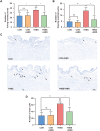Inhibition of CXCR4 in Spinal Cord and DRG with AMD3100 Attenuates Colon-Bladder Cross-Organ Sensitization
- PMID: 35023903
- PMCID: PMC8747645
- DOI: 10.2147/DDDT.S336242
Inhibition of CXCR4 in Spinal Cord and DRG with AMD3100 Attenuates Colon-Bladder Cross-Organ Sensitization
Abstract
Background: Cross-sensitization of pelvic organs is one theory for why symptoms of gut sickness and interstitial cystitis/bladder pain syndrome overlap. Experimental colitis has been shown to trigger bladder hyperactivity and hyperalgesia in rats. The chemokine receptor CXCR4 plays a key role in bladder function and central sensitization. We aim to study the role of CXCR4 and its inhibitor AMD3100 in colon-bladder cross-organ sensitization.
Methods: The colitis model was established by rectal infusion of trinitrobenzene sulfonic acid. Western blot and immunofluorescence were used to assess the expression and distribution of CXCR4. Intrathecal injection of AMD3100 (a CXCR4 inhibitor) and PD98059 (an ERK inhibitor) were used to inhibit CXCR4 and downstream extracellular signal-regulated kinase (ERK) in the spinal cord and dorsal root ganglion (DRG). Intravesical perfusion of resiniferatoxin was performed to measure the pain behavior counts of rats, and continuous cystometry was performed to evaluate bladder voiding function.
Results: Compared to the control group, CXCR4 was expressed more in bladder mucosa and colon mucosa, L6-S1 dorsal root ganglion (DRG), and the corresponding segment of the spinal dorsal horn (SDH) in rats with colitis. Moreover, intrathecal injection of the AMD3100 suppressed bladder overactivity, bladder hyperalgesia, and mastocytosis symptoms caused by colitis. Furthermore, AMD3100 effectively inhibited ERK activation in the spinal cord induced by experimental colitis. Finally, treatment with PD98059 alleviated bladder overactivity and hyperalgesia caused by colitis.
Conclusion: Increased CXCR4 in the DRG and SDH contributes to colon inflammation-induced bladder overactivity and hyperalgesia partly via the phosphorylation of spinal ERK. Treatment targeting the CXCR4/ERK pathway might provide a potential new approach for the comorbidity between the digestive system and the urinary system.
Keywords: ERK; colitis; pain; sensory afferents; urgency; visceral hypersensitivity.
© 2022 Zhang et al.
Conflict of interest statement
The authors declare that they have no conflicts of interest regarding this work nor the publication of this paper.
Figures







Similar articles
-
Chemokine receptor CXCR4 activates the RhoA/ROCK2 pathway in spinal neurons that induces bone cancer pain.Mol Pain. 2020 Jan-Dec;16:1744806920919568. doi: 10.1177/1744806920919568. Mol Pain. 2020. PMID: 32349612 Free PMC article.
-
Upregulation of Chemokine CXCL12 in the Dorsal Root Ganglia and Spinal Cord Contributes to the Development and Maintenance of Neuropathic Pain Following Spared Nerve Injury in Rats.Neurosci Bull. 2016 Feb;32(1):27-40. doi: 10.1007/s12264-015-0007-4. Epub 2016 Jan 19. Neurosci Bull. 2016. PMID: 26781879 Free PMC article.
-
Role of microglia in the spinal cord in colon-to-bladder neural crosstalk in a rat model of colitis.Neurourol Urodyn. 2018 Apr;37(4):1320-1328. doi: 10.1002/nau.23484. Epub 2018 Jan 19. Neurourol Urodyn. 2018. PMID: 29350427
-
Elevated plasma CXCL12 leads to pain chronicity via positive feedback upregulation of CXCL12/CXCR4 axis in pain synapses.J Headache Pain. 2024 Dec 3;25(1):213. doi: 10.1186/s10194-024-01917-w. J Headache Pain. 2024. PMID: 39627724 Free PMC article.
-
Do the urinary bladder and large bowel interact, in sickness or in health? ICI-RS 2011.Neurourol Urodyn. 2012 Mar;31(3):352-8. doi: 10.1002/nau.21228. Epub 2012 Feb 29. Neurourol Urodyn. 2012. PMID: 22378593 Free PMC article. Review.
Cited by
-
Autonomic Nervous System Dysfunction Is Related to Chronic Prostatitis/Chronic Pelvic Pain Syndrome.World J Mens Health. 2024 Jan;42(1):1-28. doi: 10.5534/wjmh.220248. Epub 2023 Apr 19. World J Mens Health. 2024. PMID: 37118962 Free PMC article. Review.
-
The Unmet Needs for Studying Chronic Pelvic/Visceral Pain Using Animal Models.Biomedicines. 2023 Feb 24;11(3):696. doi: 10.3390/biomedicines11030696. Biomedicines. 2023. PMID: 36979674 Free PMC article. Review.
-
The CXCL12/CXCR4 Axis: An Emerging Therapeutic Target for Chronic Pain.J Pain Res. 2025 May 21;18:2583-2603. doi: 10.2147/JPR.S509541. eCollection 2025. J Pain Res. 2025. PMID: 40417076 Free PMC article. Review.
-
MIF-Modulated Spinal Proteins Associated with Persistent Bladder Pain: A Proteomics Study.Int J Mol Sci. 2024 Apr 19;25(8):4484. doi: 10.3390/ijms25084484. Int J Mol Sci. 2024. PMID: 38674069 Free PMC article.
References
MeSH terms
Substances
LinkOut - more resources
Full Text Sources
Miscellaneous

